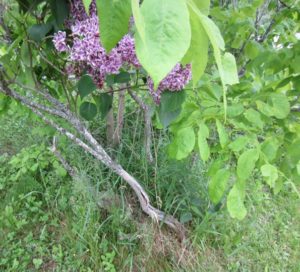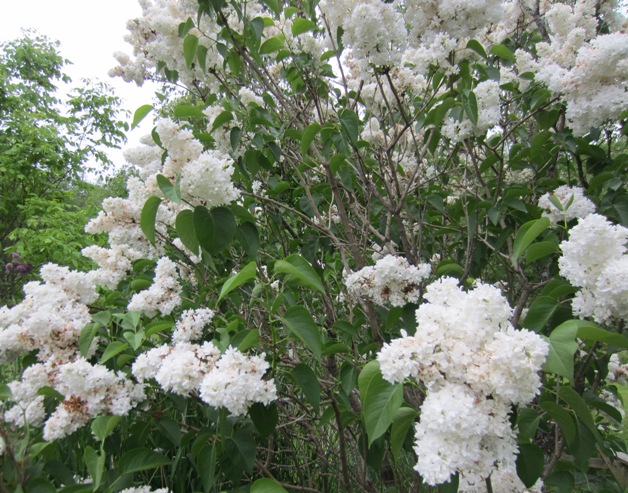I haven’t had much chance to swing at landscaping efforts out at the farm this year. That gets expensive and I have other more pressing priorities. I’m also still facing weekly flood or drought out there since I don’t yet have a well and am at the mercy of the creek and hand-carried buckets. Back at the apartment at least I have a few lonely lilac bushes that do their best to make a show and two of them in white are doing spectacularly well thanks to a fairly cool year so far. As you can see above they’re filling the air with perfume and seducing bees aplenty with botanical ‘come hither’. Their lonely purple cousin off to one side however is in dire straights.

A weed tree, birch I think, has intruded at the base and grown up to supplant the lilac. Enough so that I suspect it’ll be lost completely in a year or two. Since I’d love to expand my lilac hedge at the farm I’m going to try a bit of tricky genetic cloning by taking cuttings as soon as the flowers drop. I hear it can be troublesome but since I’ve already got pots, sand, and rooting hormone there’s no harm or expense in trying. Plus if I can propagate out a fair few more plants, I can leave plenty behind for the apartment complex to spread around and boost their own stocks.
It’s as simple as taking cuttings, stripping off lower leaves to leave nodes for roots to form, and then babysitting them for a year as they turn into viable plants to set out on their own. The difficult part as I understand it is timing. The cuttings need to be newer growth since old branches are too thick and set in their ways to root but it can’t be so new that it doesn’t have the genetic urges needed to clone themselves. Several wiser opinions I trust have advised to cut in very late spring or early summer which for us in Canada is really only just beginning. I’ll give it a go using a sand and vermiculite mix as the growing medium kept very moist but not soggy which will make it easier to check on root progress. They’ll need protective care over the winter but with any luck this roll of the dice will give me a dozen or more plants for the farm next year.
If I’m lucky in a few weeks there might also be fresh new shoots popping up from the ground level root ball which could be propagated out into new plants and with a year or two head start on cuttings in the bargain. I just won’t know if the poor purple straggler has enough oomph left to throw up new growth until later in the year. Depends on how many nutrients the invading tree has sucked out of the surrounding ground most likely.
We love a good lilac up here and in fact the Royal Botanical Gardens in Ontario puts on a showcase of the plant’s history and how well they do in our cooler climates every May. Until I get the chance for a spring road trip west, I’m just going to enjoy what I’ve got wafting in my window… like a bee.

